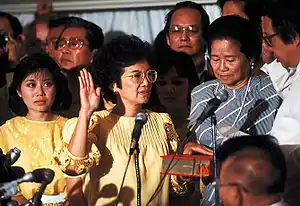Revolutionary government in the Philippines
A revolutionary government or provisional government has been declared a number of times in the Philippines by insurgent groups.
Historical revolutionary governments
Philippine Revolution
.svg.png.webp)
A first revolutionary government was initially established by the Katipunan during the Philippine Revolution in 1892, and was reestablished under a new constitution in 1894.[1] The Tejeros Convention of 1897 was held to reconcile the arguments of the two factions of the Katipunan: Magdalo and Magdiwang, and it was decided that the Katipunan must be dissolved to have an election of officers for a revolutionary government. The independence of the Philippines from Spain was declared by Katipunan leader, Emilio Aguinaldo, who is recognized as the first President of the country, on June 12, 1898. Six days later a revolutionary government over the Philippines was officially declared.[2]
Republic of Negros
The Republic of Negros (Hiligaynon: Republika sang Negros; Cebuano: Republika sa Negros; Spanish: República de Negros) was initially established during the Spanish–American War as a short-lived cantonal revolutionary republic seated in Bacolod, Negros island. On November 5, 1898, Spanish officials surrendered themselves to local Visayan leaders and a provisional government was established. The Federal Republic of Negros was established on January 1, 1899 and a notice of this was sent to Emilio Aguinaldo in Luzon.[3] Negros Island came under U.S. protection on April 30, 1899 as a separate state from the rest of the Philippine Islands.[4][5] A constitution which proposed two governors, a U.S. military governor and a civil governor elected by the voters of Negros, was framed by a committee sitting in Bacolod and sent to General Otis in Manila and was proclaimed to take effect on October 2, 1899. This reconstituted Republic operated smoothly until the province of Occidental Negros was established on April 20, 1901,[6] and annexed to the Philippine Islands by the United States as The Republic of Negros.[7]
Tagalog Republic
Tagalog Republic (Filipino: Republika ng Katagalugan or Republikang Tagalog) is a term used to refer to two revolutionary governments involved in the Philippine Revolution against Spain and the Philippine–American War. One in 1896-1897 by Andrés Bonifacio and the other in 1902-1907 by Macario Sakay, who viewed it as a continuation of the former. Both were connected to the Katipunan revolutionary movement.
Republic of Zamboanga
The Republic of Zamboanga was a short-lived sovereign republic, founded on February 28, 1899 by General Vicente Alvarez with his Zamboangueño Revolutionary Forces after the Spanish government in Zamboanga officially surrendered and turned over Real Fuerza de Nuestra Señora La Virgen del Pilar de Zaragoza to Gen. Vicente Álvarez in May 1899. Gen. Vicente Álvarez proclaimed independence and became the first and last genuinely elected president of the republic.[8] Alverez's cohort, Datu Mandi, flew the white flag over Fort Pilar on November 16, 1899 to signal American forces occupying the Philippines to enter the fort which led to the overthrow of Álvarez's government. Thereafter, the nascent republic became a U.S. protectorate or puppet government and Midel as puppet leader of U.S. was allowed to continue as president of the republic for about sixteen months.
Bangsamoro Republik
The Bangsamoro Republik, officially the United Federated States of Bangsamoro Republik,[9] was a short-lived, self-proclaimed, unrecognized breakaway state in the Philippines. Nur Misuari, chairman of the Moro National Liberation Front, issued the Proclamation of Bangsamoro Independence on July 27, 2013 in Talipao, Sulu and declared the capital of Bangsamoro to be Davao City.[10]
Aquino administration

Following the fall of the authoritarian administration of President Ferdinand Marcos, the Philippines was praised worldwide in 1986, when the so-called bloodless revolution erupted, called EDSA People Power’s Revolution.[11] Due to the People Power Revolution of February 1986, Marcos' successor, President Corazon Aquino established a revolutionary government with the signing of the "Freedom Constitution" by the virtue of Proclamation No. 3, which established human rights as the core of Philippine democracy.[2]
List
 Katipunan Revolutionary Government August 1896 - March 22, 1897[lower-alpha 1]
Katipunan Revolutionary Government August 1896 - March 22, 1897[lower-alpha 1]
 Sovereign Tagalog Nation August 1896 – May 10, 1897
Sovereign Tagalog Nation August 1896 – May 10, 1897 Tejeros Revolutionary Government March 22, 1897 – November 1, 1897
Tejeros Revolutionary Government March 22, 1897 – November 1, 1897 Republic of Biak-na-Bato November 1, 1897 – December 14, 1897
Republic of Biak-na-Bato November 1, 1897 – December 14, 1897
 Central Executive Committee April 17, 1898 – shortly after May 19, 1898
Central Executive Committee April 17, 1898 – shortly after May 19, 1898.svg.png.webp) Dictatorial Government of the Philippines May 19/June 18, 1898 – June 23, 1898
Dictatorial Government of the Philippines May 19/June 18, 1898 – June 23, 1898.svg.png.webp) Revolutionary Government of the Philippines June 23, 1898 – January 21, 1899
Revolutionary Government of the Philippines June 23, 1898 – January 21, 1899.svg.png.webp) First Philippine Republic January 22, 1899 - uncertain[lower-alpha 2]
First Philippine Republic January 22, 1899 - uncertain[lower-alpha 2]
- Cantonal Republic of Negros November 27, 1898 - July 22, 1899
- Republic of Zamboanga May 1899 - March 1903
- Republic of Negros July 22, 1899 - April 30, 1901
 Tagalog Republic May 6, 1902 - July 14, 1906
Tagalog Republic May 6, 1902 - July 14, 1906.svg.png.webp) 1986 Provisional Government of the Philippines March 25, 1986 - February 2, 1987
1986 Provisional Government of the Philippines March 25, 1986 - February 2, 1987
Proposed revolutionary governments
Duterte administration
In October 13, 2017, Rodrigo Duterte threatened the opposition that he shall declare a de facto authoritarian government through a revolutionary government that will hinder liberalism in the Philippines.[19] With his statement in his speech,“I have enough problems with criminality, drugs, rebellion and all, but if you push me to the extreme, I will declare the suspension of the writ of habeas corpus and I will arrest all of you," his threat drew concerns to democracy and human rights advocates.[20] "If he declares a revolutionary government does this mean that he is abandoning his oath?", Vice President Leni Robredo's statement after hearing the threat of the President. "Declaring a revolutionary government is against the constitution and as an elected leader, he promised to protect the 1987 Constitution," she further added.[21] The President was also criticized when he cited the revolutionary government of Corazon Aquino, experts disagree with his citing of Aquino's People Power Revolution as the 1986 revolution was initiated by the people of the Philippines, and not by an incumbent president.[22] Wendell Philips, an American abolitionist, advocate for Native Americans, orator, and attorney, as early as 19th century, already wrote: "revolutions are not made, they come".[23] It is not something that can be easily declared or proclaimed. In order for the President to proclaim it, there must be a revolution.[24] The opposition criticized Duterte's statements, stating that his revolutionary government will be another martial law age in the Philippines.[19]
He has threatened communist rebels of arrest and a full-scale war against the CPP–NPA–NDF once a revolutionary government that would last until the end of his term was declared.[22] Though by November 2017, Duterte has dropped the idea saying that he doesn't need to declare a revolutionary government in order to arrest communist rebels.[25]
Possible Effects of Declaring a Revolutionary Government
The Social Weather Survey of December 2017 reported that 39% of Filipinos disagree with the prospective of declaring a Revolutionary Government.[23] A Manila Times article reporting survey results observed that revolutions dismantle the state, inflict physical and structural violence on institutions and people, and overthrow the Constitution. The article observed that a coup initiated against a sitting government can lead to the rule of a junta-like body named as a revolutionary government.[26]
Notes
- Renato Constantino and others wrote that the Katipunan served as a shadow government.[12][13][14][15]
- The effective dissolution date of the First Philippine Republic government is not well defined
- On March 23, 1901, United States forces captured Emilio Aguinaldo, President of that government.[16]
- On April 1, 1901, Aguinaldo swore an oath accepting the authority of the United States over the Philippines and pledging his allegiance to the American government.[16]
- On April 19, 1901, Aguinaldo issued a Proclamation of Formal Surrender to the United States.[16]
- On July 4, 1902, United States president Theodore Roosevelt proclaimed an amnesty to those who had participated in the conflict.[17]
- On April 9, 2002, Philippine President Gloria Macapagal Arroyo proclaimed that the Philippine–American War had ended on April 16, 1902 with the surrender of General Miguel Malvar.[18]
References
- M.c. Halili (2004). Philippine History. Rex Bookstore, Inc. p. 138. ISBN 978-971-23-3934-9.
- Tomacruz, Sofia (25 November 2017). "When did the Philippines have a revolutionary government?". Rappler. Retrieved 1 December 2017.
- Kalaw, Maximo Manguiat (1927). The Development of Philippine Politics. Oriental commercial. p. 148.
- Two-article series:
- "Pacete: The fate of the Federal Republic of Negros". Sun-Star Philippines.
- "Pacete: The fate of the Federal Republic of Negros 2". Sun-Star Philippines.
- "Negros History". Sillman University. The Philippine Revolution.
- Victoriano D. Diamonon (1920). The Development of Self-government in The Philippine Islands. University of Iowa. pp. 22-25.
- Zaide, Gregorio F. (1970). Philippine Constitutional History and Constitutions of Modern Nations: With Full Texts of the Constitutions of the Philippines and Other Modern Nations. Modern Book Co. p. 34.
- Malcampo, Hermenegildo (2006). Historia de Zamboanga.
- "Bangsamoro Constitution: Road map to Independence and National self-determination". MNLF official website. August 23, 2013. Archived from the original on September 13, 2013. Retrieved September 8, 2013.
- "WHO IS AFRAID OF MINDANAO INDEPENDENCE?". August 14, 2013. Archived from the original on September 15, 2013. Retrieved November 19, 2013.
- "EDSA People Power Revolution". www.philippine-history.org. Retrieved 2019-12-03.
- Constantino 1975, pp. 179–181
- Borromeo & Borromeo-Buehler 1998, p. 25 (Item 3 in the list, referring to Note 41 at p. 61, ^ Borromeo & Borromeo-Buehler 1998, p. 135 (in "Document G", Account of Mr. Briccio Brigado Pantas).
- Halili & Halili 2004, pp. 138–139.
- Severino, Howie (November 27, 2007), Bonifacio for (first) president, GMA News.
- Philippine History Module-based Learning I' 2002 Ed. Rex Bookstore, Inc. p. 162. ISBN 978-971-23-3449-8.
- "General amnesty for the Filipinos; proclamation issued by the President" (PDF). The New York Times. New York City. July 4, 1902.
- "Speech of President Arroyo during the Commemoration of the Centennial Celebration of the end of the Philippine–American War April 16, 2002". Official Gazette. Government of the Philippines. Archived from the original on 2016-10-11.
- Placido, Dharel. "Duterte threatens to set up revolutionary government". ABS-CBN News.
- "Duterte warns of 'revolutionary government' and arrests". AP NEWS. 2019-04-05. Retrieved 2019-12-04.
- "Robredo: Declaring 'revolutionary government' unconstitutional". philstar.com. Retrieved 2019-12-04.
- Salaverria, Leila (13 August 2017). "Duterte threatens to adopt Cory's revolutionary style gov't vs destab plotters". Philippine Daily Inquirer. Retrieved 2 December 2017.
- "The risks of a revolutionary government". The Manila Times. Retrieved 2019-12-04.
- Berongoy, Fatima (2017-10-26). "5 Effects of a Revolutionary Government under Duterte's Administration". Reporter.PH. Retrieved 2019-12-04.
- Romero, Alexis (22 November 2017). "Duterte nixes idea of a revolutionary government". The Philippine Star. Retrieved 2 December 2017.
- Mangahas, Mahar. "No to 'Revolutionary Government'". opinion.inquirer.net. Retrieved 2019-12-04.
Bibliography
- Borromeo, Soledad Masangkay; Borromeo-Buehler, Soledad (1998), The cry of Balintawak: a contrived controversy : a textual analysis with appended documents, Ateneo de Manila University Press, ISBN 978-971-550-278-8.
- Constantino, Renato (1975), The Philippines: A Past Revisited, ISBN 971-8958-00-2.
- Halili, Christine N; Halili, Maria Christine (2004), Philippine History, Rex Bookstore, Inc., ISBN 978-971-23-3934-9.